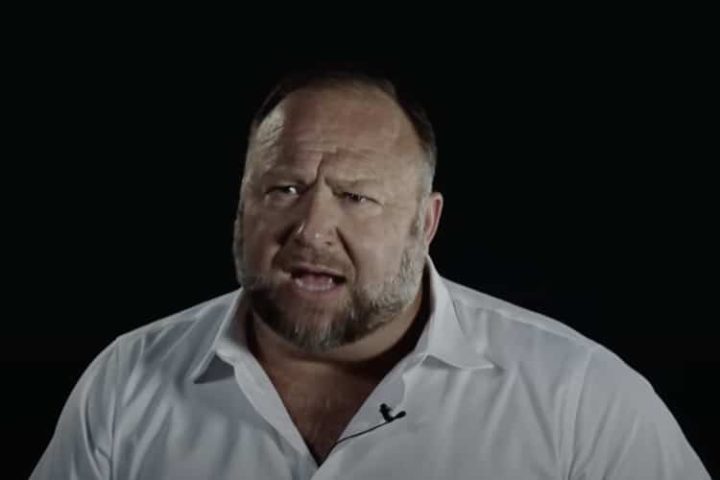
Alex’s War is a documentary by Alex Lee Moyer, focusing on iconic media personality Alex Jones. It starts in November 2020, with lush music framing shots of crowd scenes as MAGA supporters interact with Black Lives Matter activists. It quickly segues into Jones’ intellectual genealogy, wherein he discusses books he found on his parents’ shelves, from The Commentaries of Julius Caesar, to Sun Tzu’s The Art of War, to the philosophy of Friedrich Nietzsche.
An inflection-point was his discovery of Gary Allen’s None Dare Call It Conspiracy. His maternal uncle was “involved in all sorts of clandestine activities in Central America and came back and [told] us stuff,” said Jones, adding, “My dad had friends who were in the John Birch Society. So there was a background noise from them about the one-world government and the cashless society and breakup of the family and all this.” He concluded his remarks, saying, “Basically, I just grew up seeing things behind the scenes.”
This remark is apropos, given the fact that the documentary is a glimpse “behind the scenes” of his broadcast network, Infowars. We meet Mike Hanson, Alex’s first cameraman, as well as other current Infowars personalities including Rob Dew, Ali Alexander, Owen Shroyer, and a slew of producers and technicians buzzing with activity backstage to make the gears of the machine turn.
The documentary progresses to the “Stop the Steal” effort after the 2020 presidential election, to coverage of the Orwellian Covid-19 pandemic, to digressions about Agenda 2030.
Peppered among the darker themes are moments of levity and humor and crudeness — one of the crude, darkly humorous examples coming when Jones urinates on the Georgia Guidestones; a more straightforward comedic example coming when the director includes a satirical music video that a viewer made by autotuning an Alex Jones dialogue and turning it into a novelty song.
Archival footage then comes up like a flashback to show us his origins at Access TV in Austin, Texas, where the steely-eyed young Jones eclipsed the previous charisma-challenged host Jeff Davis. The younger man’s rise began with his coverage of the 1995 Oklahoma City bombing. From there he made waves, doing ongoing reporting on the government’s 1993 assault on the Branch Davidian compound in Waco, Texas.
It was here that Jones began to gain traction with a wider audience.
Writer Justin Ling recounted this part of Jones’ career, in his article “How a Crazy Plan to Rebuild Waco Compound Gave Us Alex Jones” for the Daily Beast in late 2021. Ling described how Jones “was leading a charge to rebuild the Branch Davidian compound from the ground-up. In the process, he would wind up building up a whole new conspiracy empire.” Ling then went on to relate how Jones acquired the property where the siege took place, constructed a church on the premises, and set up a “Waco Holocaust Museum” commemorating the FBI’s killing of David Koresh and 80 of his followers.
These events are recounted in the documentary, where it’s further explained that Jones’ extracurricular activities related to Waco caused friction between him and executives at Access TV.
Eventually, he was fired for refusing to discontinue coverage of the events. Subsequently, he embarked in 1997 on a venture to create his documentary production company called “Infowars.” He took the proceeds from the documentaries he sold and purchased ads across media. By 1999, he was on 100 radio stations, with 8 million listeners. It was the heyday of talk radio, and Jones rode the crest up to greater fame when he captured footage of Bohemian Grove.
Incidentally, Jones was initially told about Bohemian Grove by a gonzo journalist from England named Jon Ronson. Ronson had previously written a book called Them: Adventures With Extremists, in which one of the people he profiled was Jones. As a sort of proto-Louis Theroux, Ronson did off-the-wall documentaries for the BBC, where he covered eccentric characters and fringe figures for the establishment media. Ronson said that it was he who wanted to infiltrate Bohemian Grove, but, fearing litigation, he outsourced the job to Alex Jones. But it was Ronson who provided intelligence and logistics for the enterprise.
This is when the documentary first starts to become gripping, as real footage is showcased of the chilling occult ceremonies that took place at the elitist retreat in California. We watch as Jones and cameraman Mike Hanson sneak into the event and surreptitiously film corporate leaders, media honchos, and notable politicos as they engage in neo-pagan rites designed to propitiate the god Moloch before a giant owl statue. The ritual is called the “Cremation of Care” ceremony, where a mock sacrifice based on immolating a child is carried out. As Jones and his cameraman capture this modern reinterpretation of the esoteric ritual (and, more importantly, document the illustrious individuals participating in the proceedings), one gets a sinking feeling about the character and mental health of our so-called leaders. And Jones’ worldview acquired a dose of credibility — credibility that increased when the Texas firebrand, in July of 2001, correctly predicted the terrorist attack of 9/11 months before it actually happened.
Capitalizing on these successes, Jones was, little by little, earning an international reputation and a loyal following.
It’s here that the documentary leaps forward to December 2020, in the wake of the contested presidential election. This shift takes place around halfway through the film — and creates an interesting juxtaposition between the two distinct “Alex Jones periods.” In his early career at the tail end of the 20th century, Jones tried to affect the manner of a more conventional newsman. (One commentator said he was the “Dan Rather of the conspiracy world.”) Between his early career in the 1990s and the present time period, he seemed to undergo a stylistic change, reminiscent of the Howard Beale character from the 1976 movie Network. In that Academy Award-winning motion picture, we meet Howard Beale (portrayed by Peter Finch), an anchorman who turns into a populist icon when, after a nervous breakdown, he begins crying on air. Indulging in a new emotionalistic style, he yells, rants, and screams at his audience, delivering the iconic line, “I’m mad as hell, and I’m not gonna take it anymore!” (Eventually, in the film, Beale is subverted and co-opted by the corporate elite, who induce him to manipulate his audience on behalf of the globalists.)
These stylistic similarities to Howard Beale open up a number of unsettling questions, the most obvious of which is: Did Jones experience similar pressures?
As he screams into a microphone, veins bulging, spit flying while he shouts, “You look at the miserable globalists, you look at people like Bill Gates and you look at people like Mark Zuckerberg and the rest of them, they are miserable slaves of Satan!” we ask this question with too clear a sense of the answer.
At the 1:26:00-mark of the film, when Jones dourly confides that all he thinks about lately is the comfort that death will bring to him as he passes out of the physical plane, the parallels with Howard Beale are even more pronounced.
The documentary, while painting quite a favorable portrait of a complicated man (veering dangerously from Infowars to Infomercial at times), seems to unwittingly touch off certain questions — but only by inference.
Reading between the lines, one begins to wonder, “What was behind the stylistic change in Jones’ delivery that culminated in him describing himself as a ‘performance artist’ in recent legal filings?”
A second question: Regarding Jon Ronson (the man who kickstarted Jones’ career by giving him the Bohemian Grove scoop), was he really what he appeared to be? In the documentary, Jones (who comes across as a “fall guy” being set up by Ronson) expresses shock that he and his cameraman managed to evade detection on the premises while obtaining their groundbreaking footage. But what if it was more than “luck” that was on their side when they evaded security? What if they were secretly permitted to do what they did — when the organization’s leadership tapped Ronson to coordinate Jones and Hanson’s infiltration? After all, the viewer wonders what journalist develops a story, gets the blueprints for the grounds, spends all the time and money on research — only to give the career-making scoop to another person? Either Ronson is the most altruistic investigative reporter on the planet, or he is not what he seems to be.
A third question that the film leaves unaddressed: How did Alex Jones get the substantial funds (some place it at $250,000) as a person in his early 20s to purchase the property at Waco, Texas? He was working at a local cable access TV station and drew a negligible salary. Where did the money come from?
You will, of course, not find any of these questions answered (or even asked) in this documentary. Nevertheless, Alex’s War is a highly watchable primer for the casual fan of Infowars, documenting the arc of the organization’s rise as a potent political force and its subsequent hardships, after Deep State retaliation weaponized the judicial system to devastate the company’s coffers in the wake of litigation related to the events at Sandy Hook. (Many see this as a punitive action for Jones’ aid to Trump in the 2016 election.) In addition, Infowars was de-platformed from Apple, Twitter, YouTube, Facebook, Spotify, and so forth. It was the victim of full-spectrum censorship, having been removed, ultimately, from over 60 platforms.
In the end, the documentary is less evocative for what it says than what it does not say. The director almost accidentally opens up avenues for speculation by showing archival footage and first-person accounts that send the viewer’s mind down a thousand other rabbit holes. But, then again, isn’t that in the spirit of Infowars itself?



